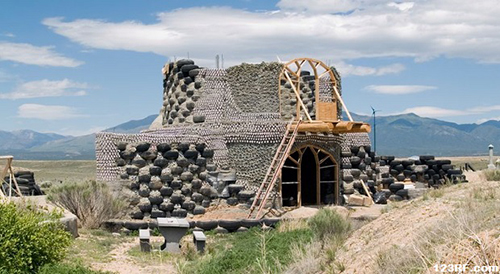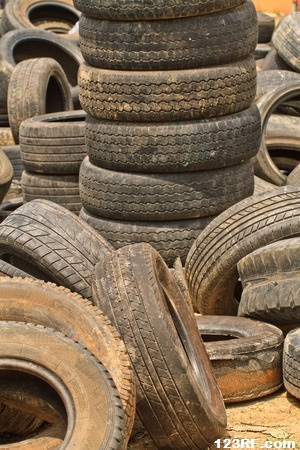Today, most people in the United States are accustomed to living in homes that have a squarish or rectangular shape. While you may not realize it, this is the least efficient shape to use if you are seeking to work with a wide range of materials, durability, and also reduce energy consumption.

In general, the rounder the shape, the better chance you have of building a durable structure with limited materials.
From that perspective, Earthship houses have a great deal to offer to anyone thinking about building an off-grid or survival home. Even if you do not utilize this specific design, you can learn more about how it works, and then take the best ideas and adapt them to your needs.
What is an Earthship House?
The Earthship house design is a trademark of architect Mike Reynolds. These homes can be built from all kinds of scrap materials. The rooms, walls, and internal plumbing are all arranged to take advantage of passive solar heating and cooling.
Aside from accounting for natural wind, sun, and other features, these homes also make use of materials that multiply the effects of natural elements to achieve a range of goals. For example, instead of using wood or plaster walls, these homes might use tin cans combined with cement. The tin cans in turn, absorb heat from the sun and then radiate it inward via vents placed in the upper portions of the wall.
An Earthship house is also designed to be completely independent from the standpoint of energy, food production, and waste removal. The building plans integrate solar power, greenhouses, composting, and human waste disposal systems. Windmills and water based power systems are also fairly easy to integrate into the power system.
Advantages
 The biggest benefit you will get from using an Earthship design revolves around the fact that these buildings are being successfully deployed in every area of the world. There are several fully operational models in ground zero of the earthquake in Haiti as well as other disaster areas. They have also been built in hot climates, cold ones, wet, dry, and just about every other place you can imagine.
The biggest benefit you will get from using an Earthship design revolves around the fact that these buildings are being successfully deployed in every area of the world. There are several fully operational models in ground zero of the earthquake in Haiti as well as other disaster areas. They have also been built in hot climates, cold ones, wet, dry, and just about every other place you can imagine.
Even though modern architects do not say much about this design, there is plenty of advice available from the founding architect as well as homeowners that have built Earthships on their own. Therefore, even if you run into problems, chances are someone else has grappled with the same issue and come up with a solution that can be duplicated.
Unlike many other structures designed for survival or environmental conservation, most everything used in building an Earthship home comes from the junk yard. You will only need a few wooden beams, and then fill in the walls with mud, cement, old tires and tin cans.
The entire structure is designed to be heated and cooled without using conventional heating systems, which will reduce energy costs to low or non-existent. Interestingly enough, as time goes by, the structure will actually become more efficient and provide more stable temperatures.
Disadvantages
When you first look at pictures of Earthship homes, they may not seem that complicated or expensive to build. Among other things, aluminum cans and old tires can be saved up or bought for a very low price. Cement and wood can also be purchased and set aside for years if that is what it takes to build up enough materials to build up a decent sized structure.
Most people that built Earthship homes were surprised to find that it cost between $100,000 and $150,000 from start to finish.
There is no question that Earthship designs are ideal when it comes to saving energy and money. Unfortunately, they may not be ideal for survival situations in which contaminated air play a major role in the crisis.
This includes nuclear and biowarfare attacks as well as volcanic explosions that release millions of pounds of very fine ash into the air. Unfortunately, even if you use air filters on incoming air vents, it will impede air flow, which will make it much harder and more expensive to achieve passive heating and cooling.
Alternatives
If you are going to spend over $100,000 on a survival home that you will most likely build yourself, it does not make sense to overlook anything that might interfere with your long term survival.
In severe cases, animals may not be able to graze, water tables will be severely polluted, and even the air itself may contain toxins that will kill or disable everyone exposed to them. Geodesic biodomes may be a bit harder to build, however they can offer 100% independence.
Another alternative to Earthships revolves around building underground. You can build homes in caves, abandoned missile silos, old mines, and just about any other place where you can safely get several feet underground and create a living space for humans, animals, and plants. Perhaps it can even be said that any land purchases for survival needs should include some feature that can be easily turned into a complete underground living facility.
Earthship home designs offer many things to consider for those who want a comfortable home that will withstand a wide range of disaster scenarios. At this time, materials for building these homes are plentiful, and there is plenty of information available to help you overcome a range of problems.
On the other hand, it should be noted that some additional modifications may be needed for extreme survival situations. By the time you make these modifications, you may find that underground or geodesic biodomes will offer better value for your money and more durability than expected.
This article has been written by Carmela Tyrell for Survivopedia.
_______________________________________________________
Learn from the best the most complete survival tactics, tips, skills and ideas like how to make pemmican, snow shoes, knives, soap, beer, smoke houses, bullets, survival bread, water wheels, herbal poultices, Indian round houses, root cellars, primitive navigation, and much more at: The Lost Ways .
Here’s just a glimpse of what you’ll find in The Lost Ways:
From Ruff Simons, an old west history expert and former deputy, you’ll learn the techniques and methods used by the wise sheriffs from the frontiers to defend an entire village despite being outnumbered and outgunned by gangs of robbers and bandits, and how you can use their wisdom to defend your home against looters when you’ll be surrounded.
Native American ERIK BAINBRIDGE – who took part in the reconstruction of the native village of Kule Loklo in California, will show you how Native Americans build the subterranean roundhouse, an underground house that today will serve you as a storm shelter, a perfectly camouflaged hideout, or a bunker. It can easily shelter three to four families, so how will you feel if, when all hell breaks loose, you’ll be able to call all your loved ones and offer them guidance and shelter? Besides that, the subterranean roundhouse makes an awesome root cellar where you can keep all your food and water reserves year-round.
From Shannon Azares you’ll learn how sailors from the XVII century preserved water in their ships for months on end, even years and how you can use this method to preserve clean water for your family cost-free.
Mike Searson – who is a Firearm and Old West history expert – will show you what to do when there is no more ammo to be had, how people who wandered the West managed to hunt eight deer with six bullets, and why their supply of ammo never ran out. Remember the panic buying in the first half of 2013? That was nothing compared to what’s going to precede the collapse.
From Susan Morrow, an ex-science teacher and chemist, you’ll master “The Art of Poultice.” She says, “If you really explore the ingredients from which our forefathers made poultices, you’ll be totally surprised by the similarities with modern medicines.” Well…how would you feel in a crisis to be the only one from the group knowledgeable about this lost skill? When there are no more antibiotics, people will turn to you to save their ill children’s lives.
And believe it or not, this is not all…
Table Of Contents:
The Most Important Thing
Making Your Own Beverages: Beer to Stronger Stuff
Ginger Beer: Making Soda the Old Fashioned Way
How North American Indians and Early Pioneers Made Pemmican
Spycraft: Military Correspondence During The 1700’s to 1900’s
Wild West Guns for SHTF and a Guide to Rolling Your Own Ammo
How Our Forefathers Built Their Sawmills, Grain Mills,and Stamping Mills
How Our Ancestors Made Herbal Poultice to Heal Their Wounds
What Our Ancestors Were Foraging For? or How to Wildcraft Your Table
How Our Ancestors Navigated Without Using a GPS System
How Our Forefathers Made Knives
How Our Forefathers Made Snow shoes for Survival
How North California Native Americans Built Their Semi-subterranean Roundhouses
Our Ancestors’Guide to Root Cellars
Good Old Fashioned Cooking on an Open Flame
Learning from Our Ancestors How to Preserve Water
Learning from Our Ancestors How to Take Care of Our Hygiene When There Isn’t Anything to Buy
How and Why I Prefer to Make Soap with Modern Ingredients
Temporarily Installing a Wood-Burning Stove during Emergencies
Making Traditional and Survival Bark Bread…….
Trapping in Winter for Beaver and Muskrat Just like Our Forefathers Did
How to Make a Smokehouse and Smoke Fish
Survival Lessons From The Donner Party
Get your paperback copy HERE
CHECK OUR survival and prepping solutions
If you found this article useful, please like our Facebook page and stay up to date with the latest articles.
WHAT TO READ NEXT:
20 LOST RECIPES FROM THE PIONEERS: WHAT THEY COOKED IN THEIR JOURNEY WESTWARD
SEVEN CLASSIC GREAT DEPRESSION ERA RECIPES GRANDMA USED TO MAKE
POTTED MEAT: A LOST SKILL OF LONG TERM MEAT STORAGE
BACK TO BASICS: HOW TO MAKE AND PRESERVE LARD
THE BEST WAY TO STOCKPILE VEGETABLES OFF-GRID
OLD FASHIONED PRESERVING-GRANDPA’S RECIPE FOR CURED SMOKED HAM
HOW TO MAKE GUNPOWDER THE OLD FASHIONED WAY
SURVIVAL HERBAL RECIPES FROM OUR ANCESTORS
OTHER USEFUL RESOURCES:
The 3 Pioneer Survival Lessons We Should Learn
The Most Effective Home Defense Strategies
Old School Hacks for Off-Grid Living
The Medical Emergency Crash Course
The Smart, Easy Way to Food Independence
How to Survive the Coming 100 Years Long Drought
About Carmela Tyrell
Carmela Tyrrell is committed to off gridding for survival and every day life. She is currently working on combining vertical container gardening with hydroponics. Tyrrell is also exploring ways to integrate magnetic and solar power generation methods. On any given day, her husband and six cats give thanks that she has not yet blown up the house. You can send Carmela a message at editor [at] survivopedia.com.

